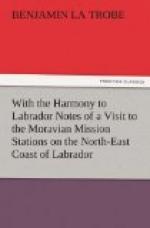Tuesday, September 4th.—Before we had done breakfast the flag was flying at the mizen-gaff of the “Harmony,” summoning her passengers to start for Ramah. We speedily packed our baggage, but the wind died away ere the anchor could be lifted, and we did not sail out of the bay till the next morning. So some of us utilized the interval for the ascent of the Sonnenkoppe, so called because it hides the sun from Okak for several weeks of the year. High on the hill was a pond, which superstitious natives believe to be inhabited by a sea-monster left there by the flood. A larger lake is named after our Irish missionary Bramagin. Arrived at the summit, a very wide prospect over innumerable mountains and blue sea, dotted with white icebergs, rewarded our climb. Far below us we could see the mission-house, centre of blessed influence, for the Eskimo village, divided into Lower Okak by the beach, and Upper Okak on the slope beyond. Strange to think that, with the exception of one settler family in Saeglek Bay, the nearest group of fixed human habitations is at Hebron, seventy miles to the north. Easier than the ascent was the descent, over rocks and stones, beautifully variegated mosses, and low vegetation changing its hue to a brilliant red as the autumn advances.
FROM OKAK TO RAMAH.
Wednesday, September 5th.—About ten o’clock this morning a strong breeze sprang up, and we speedily left behind us the friendly red-roofed mission-house at Okak. When we entered the open sea and turned northwards we passed near a grounded iceberg, curiously hollowed out by the action of the waves. The seaward face of Cape Mugford is even grander than its aspect from the heights around Okak. It seems to be a perpendicular precipice of about 2000 feet, with white base, and a middle strata of black rocks surmounted by castellated cliffs. Presently the remarkably jagged peaks on the island of Nennoktuk came out from behind the nearer headland. There’s a sail to the right of it! No, she is not another schooner; she is two-masted and square rigged, and therefore the “Gleaner,” the only brigantine in these waters. So the two Moravian vessels pass one another within a mile or two, the “Gleaner” on her way southward from Hebron to Okak, whence she will take Mr. Bourquin home to Nain, the “Harmony” pursuing her northward course past Hebron to Ramah. The captains, who are consigns, exchange a salute by running up their flags, but the sea is too rough to put down a boat.




